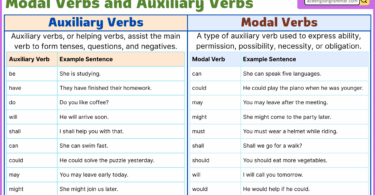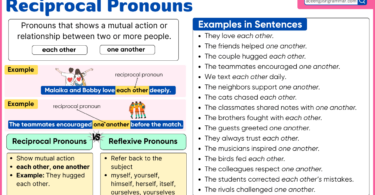Conjunctive adverbs are words that connect ideas in a sentence. They help to show how two ideas are related to each other. Unlike conjunctions, which join two complete sentences, conjunctive adverbs connect parts of a sentence. They are often used to show contrast, addition, or time. Understanding conjunctive adverbs can make your writing clearer and more effective. In this article, we’ll explore the basics of conjunctive adverbs and provide examples of how to use them in your writing. So, let’s get started!
Table of Contents
What Are Conjunctive Adverbs?
Conjunctive adverbs are words that function as adverbs and conjunctions, linking ideas or clauses within a sentence. Unlike typical adverbs that modify verbs, adjectives, or other adverbs, conjunctive adverbs primarily serve a connective role. The word “conjunctive” refers to joining or connecting, and “adverb” describes a word that modifies verbs, adjectives, or other adverbs. Therefore, a conjunctive adverb is a word that helps to express logical connections, transitions, or contrasts between ideas.
Common conjunctive adverbs include words like “however,” “therefore,” “consequently,” “nevertheless,” and “meanwhile.” These adverbs not only join two independent clauses but also provide additional information about the relationship between them. For example, in the sentence “She studied hard; therefore, she aced the exam,” the conjunctive adverb “therefore” indicates a cause-and-effect relationship between studying hard and acing the exam. It helps readers understand the logical progression of ideas.
Examples:
- I don’t like pizza; instead, I prefer pasta.
- She studied hard; hence, she aced the exam.
- He was tired; in addition, he had a headache.
- She woke up late; therefore, he missed the bus.
- He wanted to go out; however, it started raining.
How to Use Conjunctive Adverbs?
Understanding how to use conjunctive adverbs correctly is essential for effective communication. Here are some guidelines to follow:
- Identify Relationship: Understand the relationship between the two sentences or clauses you want to connect. Determine if it’s a contrast, addition, cause and effect, or another relationship.
- Choose the Right Adverb: Select an appropriate conjunctive adverb that conveys the specific relationship you identified. Common examples include “however,” “therefore,” “meanwhile,” and “consequently.”
- Punctuation: Use a semicolon before the conjunctive adverb when joining two independent clauses. If the conjunctive adverb appears within a clause, use commas before and after it.
- Understand Context: Choose conjunctive adverbs that fit the context of your writing to convey the intended relationship between ideas effectively.
- Maintain Consistency: Use conjunctive adverbs consistently throughout your writing to provide a smooth flow of ideas and maintain coherence.
- Avoid Comma Splices: Do not connect two independent clauses with just a comma. Always use a semicolon or other appropriate punctuation along with the conjunctive adverb.
- Placement in a Sentence: Conjunctive adverbs appear at the beginning or end of a sentence. If they’re in the middle, they are often set off by commas. For example:
- Beginning: However, I will attend the party.
- Middle: I will, therefore, prepare a presentation.
- End: He finished the project on time; however.
Common Conjunctive Adverbs
Moreover: Adds information or emphasizes a point.
- “The cake was delicious, and moreover, it was beautifully decorated.”
However: Used to show contrast or unexpected results.
- “She wanted to go; however, it started raining.”
Therefore: Indicates a conclusion or result.
- “He forgot his umbrella; therefore, he got wet in the rain.”
Meanwhile: Highlights something happening at the same time.
- “She was cooking; meanwhile, he was setting the table.”
Furthermore: Adds more information or supports a point.
- “The project was challenging; furthermore, it was due in two days.”
Additionally: Adds extra information or points.
- “They bought a new car; additionally, they upgraded their home appliances.”
Nevertheless: Contrasts a previous statement or situation.
- “It was raining; nevertheless, they decided to go for a walk.”
Otherwise: Indicates an alternative or different outcome.
- “Study hard; otherwise, you might fail the exam.”
Consequently: Shows a cause-and-effect relationship.
- “They missed the train; consequently, they arrived late.”
Still: Despite a preceding situation, this adverb introduces an opposing idea.
- “It was late; still, they continued the party.”
Thus: Indicates a conclusion or outcome.
- “He forgot his lunch; thus, he had to buy something from the cafeteria.”
Similarly: Highlights a similarity or comparison.
- “She enjoys painting; similarly, her brother loves drawing.”
Hence: This adverb indicates a reason or explanation.
- “She forgot her keys at home; hence, she couldn’t open the door.”
Subsequently: Shows a sequence of events.
- “She aced the interview and subsequently received a job offer.”
Nonetheless: Similar to “nevertheless,” indicating a contrast\unexpected outcome.
- “The movie was long; nonetheless, it was captivating.”
Functions of Conjunctive Adverbs
Conjunctive adverbs are words that connect and relate ideas within sentences. They play a crucial role in indicating relationships between clauses, sentences, or even paragraphs. Here are some basic functions of conjunctive adverbs:
- Showing Contrast::
- Examples: however, nevertheless, on the other hand, in contrast, conversely.
- Function: Introduces a contrasting idea or viewpoint to the previous statement.
- Expressing Comparison:
- Examples: similarly, likewise, in the same way.
- Function: Highlights a similarity or comparison between two ideas or situations.
- Indicating Cause and Effect:
- Examples: therefore, thus, consequently, accordingly.
- Function: Indicates a cause-and-effect relationship between the two clauses or sentences.
- Expressing Sequence and Time:
- Examples: meanwhile, meanwhile, subsequently, afterward, finally.
- Function: Shows the order or sequence of events or ideas.
- Adding Information:
- Examples: furthermore, moreover, in addition, additionally.
- Function: Adds information or reinforces the preceding statement.
- Emphasizing a Point:
- Examples: indeed, in fact, certainly, surely.
- Function: Adds emphasis to the statement that follows.
- Introduce a Concession:
- Examples: nevertheless, nonetheless, although, even though.
- Function: Introduces a concession or contrast to the preceding statement, acknowledging a counterpoint.
- Expressing Condition:
- Examples: if, unless, provided that, in case.
- Function: Introduces a condition or circumstance under which the statement in the main clause is valid.
- Providing Purpose:
- Examples: so that, in order that.
- Function: Indicates the purpose or intention behind the action stated in the main clause.
- Summarizing or Concluding:
- Examples: in conclusion, to sum up, overall.
- Function: Introduces a summary or conclusion of the preceding information.
- Providing Examples
- Examples: for example, for instance, to Illustrate.
- Function: introduce examples that support or illustrate the preceding statement.
List of Conjunctive Adverbs
- Accordingly
- Additionally
- Admittedly
- Also
- Anyway
- Afterward
- Besides
- Certainly
- Comparatively
- Consequently
- Contrarily
- Conversely
- Elsewhere
- Equally
- Finally
- Furthermore
- Hence
- However
- Indeed
- Instead
- Likewise
- Meanwhile
- Moreover
- Namely
- Nevertheless
- Nonetheless
- Notably
- Now
- On the contrary
- On the other hand
- Otherwise
- Similarly
- Still
- Subsequently
- Surprisingly
- Then
- Therefore
- Thus
- Ultimately
- Unquestionably
- Whereas
- Alternatively
- Altogether
- Anyhow
- All in all
- Above all
- As a result
- As mentioned
- At the same time
- Consequently
- Correspondingly
- Despite
- Eventually
- For example
- For instance
- For this reason
- Henceforth
- In addition
- In any case
- In contrast
- In fact
- In conclusion
- In other words
- In particular
- In short
- In summary
- In the meantime
- In turn
- Incidentally
- Instead
- Later
- Likewise
- Meanwhile
- Moreover
- Nevertheless
- Next
- Nonetheless
- Notwithstanding
- Now
- Otherwise
- Overall
- Plus
- Similarly
- Specifically
- Basically
- Clearly
- Exclusively
Example Sentences
- He loves playing basketball; moreover, he excels in it.
- The weather was cold; therefore, we wore warm jackets.
- James forgot his lunch; as a result, he had to buy food at school.
- We had a flat tire; hence, we couldn’t make it to the party.
- It was raining heavily; nonetheless, they decided to go for a hike.
- The cake was delicious; furthermore, it was beautifully decorated.
- Lisa is an excellent pianist; in addition, she plays the violin.
- I have a busy schedule; nonetheless, I’ll find time to help you.
- The meeting was canceled; thus, we had an unexpected break.
- Jenny enjoys hiking; similarly, her friends love outdoor activities.
- The party was loud; therefore, we decided to leave early.
- We ran out of time; hence, we couldn’t complete the task.
- The train was delayed; nevertheless, we reached our destination.
- We need more information; hence, we will conduct further research.
- The store was closed; therefore, we couldn’t buy groceries.
- The book was interesting; nevertheless, I didn’t finish reading it.
- She was tired; nevertheless, she continued working on her project.
Conjunctive Adverbs Exercise
1. What is a conjunctive adverb?
- A connecting word
- A descriptive adjective
- A punctuation mark
- A proper noun
2. Which of the following is a conjunctive adverb indicating contrast?
- And
- Therefore
- However
- Moreover
3. Choose the conjunctive adverb that shows cause and effect:
- Similarly
- Consequently
- Furthermore
- Nonetheless
4. What does the conjunctive adverb “meanwhile” indicate?
- Addition
- Contrast
- Sequence
- Cause and effect
5. Which conjunctive adverb is used to add information?
- Therefore
- Furthermore
- Meanwhile
- Otherwise
6. What punctuation is typically used before a conjunctive adverb?
- Colon (:)
- Comma (,)
- Period (.)
- Exclamation mark (!)
7. Which is not a conjunctive adverb?
- Furthermore
- But
- Instead
- Quickly
8. Which conjunctive adverb is used for adding information?
- Thus
- Additionally
- Hence
- Nevertheless
9. Which conjunctive adverb is used to emphasize a point?
- Moreover
- Nonetheless
- Meanwhile
- Similarly
10. Choose the correct conjunction for the following sentence: “She wanted to go out; ____, it was raining.”
- However
- Moreover
- Because
- So
Answers:
- A connecting word
- However
- Consequently
- Sequence
- Furthermore
- Comma (,)
- Quickly
- Additionally
- Moreover
- However
FAQs
Q1: What is a conjunctive adverb?
A conjunctive adverb is a connecting word that joins two independent clauses or sentences, providing a bridge between ideas. It helps indicate relationships such as contrast, addition, cause and effect, time, and more.
Q2: What are some common examples of conjunctive adverbs?
Common conjunctive adverbs include “however,” “nevertheless,” “consequently,” “furthermore,” “moreover,” “meanwhile,” “nonetheless,” “similarly,” “otherwise,” and “therefore.”
Q3: How do conjunctive adverbs differ from coordinating conjunctions?
While both conjunctive adverbs and coordinating conjunctions connect ideas, conjunctive adverbs offer a wider range of connections and transitions. They are more flexible in showing various relationships, whereas coordinating conjunctions like “and,” “but,” and “or” are more limited in their roles.
Q4: Give some examples of conjunctive adverbs.
Here are some examples of conjunctive adverbs:
- However, she didn’t want to go to the party.
- He’s smart. Furthermore, he’s hardworking.
- Meanwhile, I’ll finish my homework.
- She wanted to travel; she saved money, therefore.
- We were late; consequently, we missed the bus.
You May Also Like:




Leave a Comment